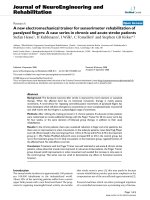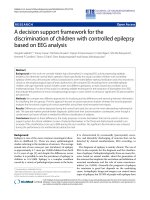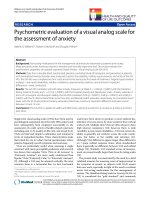A new genus record for the flora of Turkey: Tetradiclis Stev. ex M.Bieb. (Zygophyllaceae)
Bạn đang xem bản rút gọn của tài liệu. Xem và tải ngay bản đầy đủ của tài liệu tại đây (1.43 MB, 5 trang )
Turk J Bot
29 (2005) 403-407
© TÜB‹TAK
Research Note
A New Genus Record for the Flora of Turkey: Tetradiclis Stev. ex
M.Bieb. (Zygophyllaceae)
Ergin HAMZAO⁄LU
Department of Biology, Yozgat Faculty of Science and Arts, Erciyes University, 66100 Yozgat - TURKEY
Ahmet DURAN
Department of Biology, Faculty of Education, Selçuk University, 42090 Meram, Konya - TURKEY
Hossein AKHANI
Department of Biology, Faculty of Science, Tehran University, P.O. Box 14155-6455 Tehran - IRAN
Received: 11.03.2005
Accepted: 04.08.2005
Abstract: Tetradiclis tenella (Ehrenb.) Litw. (Zygophyllaceae), recently collected from K›r›kkale (Central Anatolia), is a new record
for the flora of Turkey. A description, its phytogeographical importance, a distribution map and an illustration are given.
Key Words: Tetradiclis, Zygophyllaceae, new record, Turkey
Türkiye Floras› ‹çin Yeni Bir Cins Kayd›: Tetradiclis Stev. ex M.Bieb. (Zygophyllaceae)
Özet: K›r›kkale’den (Orta Anadolu) toplanan Tetradiclis tenella (Ehrenb.) Litw. (Zygophyllaceae) Türkiye floras› için yeni bir kay›tt›r.
Türün betimi, fitoco¤rafik önemi, yay›l›fl haritas› ve çizimi verilmifltir.
Anahtar Sözcükler: Tetradiclis, Zygophyllaceae, yeni kay›t, Türkiye
Introduction
Tetradiclis Stev. ex M.Bieb. is a bitypic genus mainly
found in the Irano-Turanian region (Takhtajan, 1986).
The genus was classically known as a member of
Zygophyllaceae (Brummitt, 1992) until new molecular
phylogenetic studies showed its position within
Nitrariaceae or alternatively as its own separate family
Tetradiclidaceae (APGII, 2003). However, here the genus
was evaluated in the family Zygophyllaceae, in accordance
with the systematic of the Flora of Turkey. Tetradiclis
tenella (Ehrenb.) Litw. is widely distributed in the desert
and semi-desert zones of the Middle East, and is also
found in S & E Europe (S, E & S Russia), the Caucasus,
Afghanistan and Central Asia (mainly Turkmenistan)
(Bobrov, 1949; Nikitin, 1950; Tutin, 1968; El Hadidi,
1972; Zohary, 1972, 1973; Agnew, 1980).
The first and second authors collected some
interesting plants during floristic studies in Delice
(Kırıkkale), during the summer of 2002 and spring
2004. From among these was identified by the third
author Tetradiclis tenella, during a short visit to Gazi
University (Ankara) in August 2004. A description,
illustration, notes on phytogeography, a distribution map
and the endangered status of the species are provided
(Figures 1, 2).
TETRADICLIS Stev. ex M.Bieb.
Tetradiclis tenella (Ehrenb.) Litw., Trav. Mus. Bot.
Acad. Pétersb. 3: 122 (1907). (Figure 1).
Syn.: Anatropa tenella Ehrenb. in Linnaea 4: 404
(1809); T. salsa C.A.Mey. in Verz. Pflanz. Cauc.: 226
(1831); T. caspia Lindl. in Chesney. Narr. Euph. Exp. T.
95 (1868).
Type: [Egypt] Alexandria (1824). Ehrenberg (K; G,
n.v.).
Annual, 3-12 cm tall, erect to subprostrate, delicate,
glabrous, with filiform roots. Stems simple or branching
at the base and dichotomous above. Leaves succulent,
subsessile, glabrous, the lowest opposite, the others
alternate, 4-8 x 1.5-2.5 mm, pinnatisect with linear
403
A New Genus Record for the Flora of Turkey: Tetradiclis Stev. ex M.Bieb. (Zygophyllaceae)
1 cm
a
2 mm
c
d
0.5 mm
0.5 mm
e
f
g
Figure 1. Tetradiclis tenella (Ehrenb.) Litw.: a-habit, b-aspect of fruit rear, c-aspect of fruit top, d- aspect of fruit side, e- aspect of flower rear, faspect of flower top, g-seeds [A part of this figure was completely redrawn from our specimen and copied from plate 55 in the Flora of
Iraq (Agnew, 1980)].
404
E. HAMZAO⁄LU, A. DURAN, H. AKHANI
Figure 2. Habit of Tetradiclis tenella .
40N
Caspian
Sea
TURKEY
36N
TURKMENISTAN
SYRIA
IRAQ
Mediterranean
Sea
AFGHANISTAN
IRAN
32N
PAKISTAN
28N
32E
36E
40E
44E
48E
Persian
Gulf
52E
56E
60E
64E
Figure 3. Distribution map of Tetradiclis tenella in the Middle East. The new Turkish locality is
indicated by an arrow (the localities in the Caucasus and Pakistan are not shown).
segments or laciniate, obtuse. Inflorescence a spike-like
scorpioid cyme, 1-3 cm long in flower, elongating to 12
cm long in fruit. Flowers tetramerous, 0.5-1 mm in
diameter during anthesis; pedicels up to 1.5 mm long, in
axils of leaf-like bracts. Sepals, petals and stamens 4,
persistent. Sepals c. 0.5 mm long. Petals twice as long as
sepals, oblanceolate to spathulate, whitish. Ovary 4locular, dorsiventrally flattened; each loculus divided by
405
A New Genus Record for the Flora of Turkey: Tetradiclis Stev. ex M.Bieb. (Zygophyllaceae)
2-false septa into 3 compartments, the 2 outer ones
containing 1 ovule each, the inner with 4 or fewer. Fruit
a loculicidal capsule, tetragonal, 1.5-2 x 2-4 mm, at first
fleshy, later drying. Seeds small, with little endosperm;
embryo erect. Fl. 4-5, Fr. 5-6, saline places, 640-650 m.
Specimens examined: Central Anatolia. B5 Kırıkkale:
Delice, around Tekel Tuzla ‹flletmesi, 650 m, salty areas,
2 vi 2002, Hamzao¤lu 2859 & A.Duran (ADO); Delice,
Tekel Tuzlası, abandoned salt ponds, 644 m, 39° 58.548’
N – 034° 03.932’ E, 19 v 2004, Hamzao¤lu 3569 &
A.Duran (ADO, GAZI, ANK, HUB, KNYA, hb. Akhani, hb.
Y›ld›r›ml›).
Discussion
Tetradiclis tenella usually grows in moist saline places
in desertic and semi-desertic zones. It is an IranoTuranian species with a wide distribution range from NE
Africa (Egypt), throughout SW Asia (Palestine, Jordan,
Syria, Iraq, Iran, Afghanistan and Pakistan) and
northwards in Central Asia (mainly Turkmenistan), the
Caucasus and S Russia (Figure 3). In spite of its rather
wide range it is poorly represented in herbaria. The data
available in the Flora of Iraq (Agnew, 1980) indicate that
it is more common in Iraq than elsewhere. In Iran it is
very rare and is only known from a few localities (El
Hadidi, 1972).
The disjunct occurrence of Tetradiclis in Central
Anatolia adds another species to a series of species which
link the flora of salty habitats in Central Anatolia, central
and NW Iran, Syria and the Caucasus. A good example is
Microcnemum coralloides (Loscos & Pardo) Buen, which
occurs disjunctively in Central Anatolia (around the saline
Tuz Lake), central Iran (Kavire Meyghan), NW Iran, the
Syrian desert, the Caucasus and, of special interest, Spain.
Interestingly all localities except Spain more or less
overlap with the localities of Tetradiclis tenella. Recently
the third author reported Asparagus lycaonicus P.H.Davis
from central Iran, an extremely endangered species from
Tuz Lake (Akhani, 2002). Freitag et al. (1999) reported
Anabasis aphylla L. from a locality in Central Anatolia (28
km ESE Nallihan-Ankara) disjunct from the nearest
localities in East Anatolia. We also agree with parts of
their interpretation that the occurrence of such halophytic
species indicates a more continuous distribution during a
drier period in the past and former stronger floristic links
between Central Anatolia and western and southern salt
habitats.
With regard to conservation and biodiversity, we
consider this species endangered; its habitat needs to be
legally protected by the Turkish government.
The number of genera of Zygophyllaceae in the Flora
of Turkey is increased to 6 with the addition of
Tetradiclis. The genus identification key of the family was
reordered and given as follows;
Key to the genera of Zygophyllaceae in Turkey
1. Shrubs or perennial herbs
2. Leaves alternate
3. Leaves entire; plants shrubby..........4. Nitraria
3. Leaves divided; herbs..................5. Peganum
2. Leaves opposite
4. Leaves simple; spiny stipules present...............
...................................................2. Fagonia
4. Leaves with one pair of leaflets; spiny stipules
absent..................................1. Zygophyllum
1. Annuals
5. Leaves with many pairs of leaflets, not succulent;
fruit schizocarpic, heavily ornamented with spines
and tubercles.....................................3. Tribulus
5. Leaves with one pair of leaflets, succulent; fruit
loculicidal
capsule,
smooth
and
glabrous........................................6. Tetradiclis
References
Agnew ADQ (1980). Tetradiclis Stev. In: Townsend CC & Guest E (ed.).
Flora of Iraq, Vol 4. pp. 304-306 Baghdad: Min. Agric. Agr.
Reform Rep. Iraq.
APG II (2003). An update of the Angiosperm Phylogeny Group
classification for the orders and families of flowering plants: APG
II. Bot J Linn Soc 141: 399–436.
Akhani H (2002). Notes on the Flora of Iran: 1. Asparagus
(Asparagaceae) and Nitraria (Zygophyllaceae). Edinburgh J Bot
59: 295-302.
Bobrov EG (1949). Tetradiclis Stev. In: Shishkin BK (ed.). Flora of the
USSR Vol 14. pp. 151. Moscow & Leningrad.
406
E. HAMZAO⁄LU, A. DURAN, H. AKHANI
Brummitt RK (1992). Vascular plant families and genera. Kew: Royal
Botanic Gardens.
Freitag H, Vural M & Adigüzel N (1999). A remarkable new Salsola and
some new records of Chenopodiaceae from Central Anatolia
Turkey. Willdenowia 29: 123-139.
El Hadidi MN (1972). Tetradiclis Stev. In: Rechinger KH (ed.). Flora
Iranica. 98: 18. Graz-Austria.
Nikitin VV (1950). Flora Turkmeni. Akademiya Nauk SSSR. Ashgabat (in
Russian).
Tutin TG (1968). Tetradiclis Stev. In: Tutin TG, Heywood HV, Walters
SM & Webb DA, (eds.). Flora Europaea. Vol 2. pp. 205.
Cambridge: Cambridge University Press.
Zohary M (1972). Tetradiclis Stev. In: Zohary M (ed.). Flora
Palaestina.Vol 2. pp. 246. Jerusalem: The Israel Academy for
Science and Humanities.
Zohary M (1973). Geobotanical Foundations in the Middle East. Vols 12. Stuttgart: Gustav Fischer Verlag.
Takhtajan A (1986). Floristic regions of the world. Berkeley, Los
Angeles, London: University of California Press.
407









